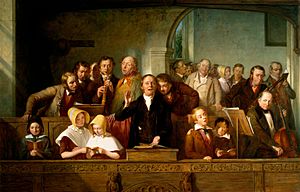West gallery music facts for kids
West gallery music is a type of church music from England. It was popular from about 1700 to 1850. People also called it Georgian psalmody because it was sung during the Georgian era. This music was sung in churches and other Christian meeting places called chapels. It included metrical psalms (songs based on Bible verses), hymns, and anthems.
The name "west gallery" comes from where the music was performed. In the 1700s, many churches built wooden balconies, or "galleries," at the west end. The church choir would sing from these galleries. Churches usually faced east, so the west gallery choir would face the altar, just like the people below them. Later, in the 1800s, people thought these galleries looked old-fashioned. Most of them were removed during church updates. Today, west gallery music is popular again, with many groups singing it.
How West Gallery Music Started
In the 1700s, many churchgoers felt that the singing in church wasn't very good. This led to the creation of amateur choirs. At first, these choirs were only made up of men.
Instruments in the Choir
Many country churches in England did not have an organ. So, choirs needed help to keep the right tune. From the mid-1700s, a bass instrument, like a cello, often joined the singers. Later, small bands started playing with the choirs. These bands used different instruments, but often included flutes, clarinets, bassoons, cellos, and violins.
At first, the instruments simply played the same notes as the singers. But over time, composers wrote more complex music. This new music had special parts just for the instruments, sometimes even like small symphonies.
What West Gallery Music Sounded Like
The music mainly included metrical psalms and anthems. A popular type of song was called a "fuguing tune." Many teachers, like Michael Beesly and William Tans'ur, wrote and sold their own psalm books. They often borrowed ideas from each other.
Printed music books were very expensive. So, many musicians created their own handwritten collections of songs. Most of these composers were not professional musicians. They learned from other psalm singers. This sometimes led to unique and surprising musical pieces.
Special Features of the Music
Early west gallery music had some interesting features:
- It sometimes used unexpected sounds that clashed a little (dissonances).
- It had strong, memorable tunes.
- The tenor voice (a male singing voice) was very important. Treble voices (higher voices, often children or women) often sang the same tune an octave higher.
- The music often used "word painting." This means the music would try to show the meaning of the words. For example, if the words talked about rising, the music might go up.
Some professional composers also wrote west gallery music. They saw it as a good way to earn money.
West Gallery Music in America
Around the mid-1700s, English country psalmody traveled to America. There, it inspired many new songs. These new songs were created by a group known as the First New England School.
Some of these American songs are still sung today in a tradition called shape note singing. A famous example is the Sacred Harp songbook. The four-part harmony, where the tenor voice leads, and the fuguing tunes from west gallery music strongly influenced American music. In many ways, American shape note music grew directly from the older English style.
Why the Music Changed
West gallery music became less common in churches for several reasons.
- More people moved to cities.
- People wanted a more formal and polite style of church worship. This led to movements like the Oxford movement.
- New hymn books, like Hymns Ancient and Modern (1861), became popular.
Also, church bands were sometimes hard for the vicar (the local priest) to manage. It was much easier to control an organist. The writer Thomas Hardy wrote a novel called Under the Greenwood Tree. It tells a fictional story about a church band being replaced by an organist. This story was based on real events in Hardy's own church. Another reason for the change was that when Methodists separated from the Anglican church, many of these bands might have split up or left.
In 1893, a Reverend named Francis William Galpin thought he had found the last church band in England. It was in Winterbourne Abbas. However, two years later, a survey found that 18 churches in Cornwall still had a band.
See also
- Anglican church music
- Larks of Dean, chapel musicians in 18th & 19th-century Lancashire
- Sing Lustily and with Good Courage, a recording including west gallery hymns
- Tate and Brady
West Gallery Composers
- Thomas Clark
- John Fawcett
- Edward Harwood
- Joseph Nicholds
- William Tans'ur
- Aaron Williams
- Joseph Williams
- Anne Steele
- John Arnold (1720–1792), composer who published The Compleat Psalmodist (1741)
Composers and Compilers in Related Traditions
- Robert Bremner, who was influential in mid-18th century Scottish psalmody
- Charles Woodmason, an Anglican clergyman and tune-book compiler



